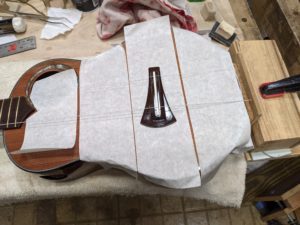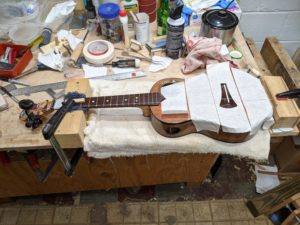The fret spacing on an instrument determines the scale length. Since the 12’th fret is an octave above the open string, the distance between the bridge and the 12’th fret is 1/2 of the scale length. Mostly …
Since when you press a string you stretch it a bit, if the 12’th fret to bridge distance were exactly the scale length, the note would be a bit sharp, from the added stretching. This stretching effect increases as you move up the fretboard since the string is getting ‘shorter’ as one uses the higher frets. The amount of stretching, and the amount that this stretching raises the note is dependent on a number of factors including the scale length, the type of string, the diameter of the string, and the height of the action.
To avoid having the note go sharp as one moves up the fretboard the saddle must be moved out a little bit beyond the actual scale length. This little bit of extra length is called the ‘compensation’. There are a number of ways of approximating the compensation, but since it is dependent on a number of factors specific to an instrument I developed a way to empirically set the bridge/saddle in the right position.
To do this, when preparing to glue the saddle down, I put the instrument on the bench, with a block with string holes in it at the bottom end, and the neck held down by a block in the middle of the fretboard. With this I can stretch the 1’st and 4’th strings over the instrument, across the not-yet-glued-bridge, in playing position. I set the action close to the final setting by adjusting the height of the saddle (as one would do on the finished instrument). Since the bridge is not glued down I can move it around and using a very accurate tuner I can get the bridge position so the open string and the string fretted at the 12’th fret play exactly an octave apart. I use the actual strings that I’m going to put on the instrument too. Once I get things right (1’st and 4’th string is an average for the other 2 strings in the middle) I mark the bridge position and proceed to glue it down. A straight saddle is always going to be a bit of an approximation for the compensation because of the differences in the strings, but I can get very close.
The example shown here is a Kasha braced baritone which is why there is an unusual bridge shape and an off-center sound hole. The top is protected with a low-tack tape since the instrument is fully finished at this point and I draw the bridge position on the tape when I get it right.

